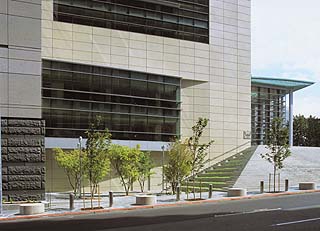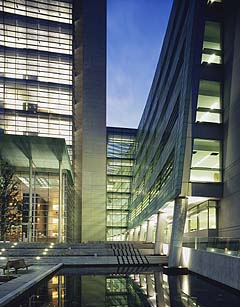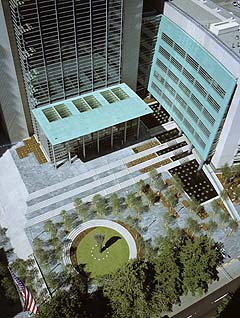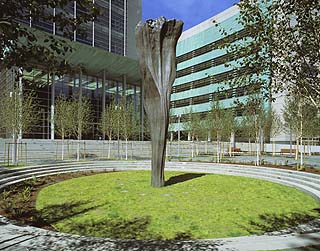|
Subscribe / Renew |
|
|
Contact Us |
|
| ► Subscribe to our Free Weekly Newsletter | |
| home | Welcome, sign in or click here to subscribe. | login |
Construction
| |
 |
September 23, 2004
Plaza offers an urban oasis
Peter Walker and Partners

Photos by Frank Ooms
Birch trees and stainless steel bollards along the street serve to help protect the courthouse while preserving its openness. Other plaza security features include structurally hardened benches, handrails and light poles.
|
As construction of high-rise office, residential and commercial development transforms the relatively fragmented edge of downtown, the new federal courthouse will provide the major public open space in this northern precinct of Seattle's core.
At the corner of Seventh Avenue and Stewart Street, the plaza fulfills such basic functions as an entryway to the courts system and a place for major assemblies and ceremonies.
The tenants also wanted the plaza to address its emerging neighborhood, to reflect its Seattle and Northwest context, and serve as a desirable downtown destination. Security was, of course, a central consideration in a site that provided all of these functions.
An informal grove

A lily fountain extends from the atrium that separates the judicial tower from the office wing. Light from the pools help illuminate the plaza.
|
The site is at once plaza and garden, a merging accomplished in large part by a paving system that forms the framework of the whole composition.
In addition to holding up under large gatherings, the paving system assures that the space not look empty during quiet times. The striped pattern alternates bands of tightly fitted pavers in a geometric pattern with bands of irregularly composed cobble pavers.
The cobbles are set with a variety of joint widths, tightly fitted, for example, where it primarily serves as a pedestrian surface; grass and moss are encouraged to grow in the wider joints so that at eye level the plaza appears to be green. The luminescent qualities of the reflective quartzite that composes both bands ensures brightness on gray winter days.
Planted within the cobble bands, a grove of 100 birch trees is a metaphor of the forests of the Northwest. (A continuous layer of structural soil under the plaza creates pavement stability while promoting long-term tree growth and storm-water infiltration.)
With its varying densities the grove looks informal from most vantage points. Its organization into stripes becomes apparent only when the building is approached on axis. The patterns and materials extend through the clear glass walls into the public spaces of the building, merging interior and exterior.
Varied elements
The following elements within the grove provide a variety of experiences:

The one-acre plaza features three shallow rises of steps that approach the portico tower entry to create a space intended to be visually and physically accessible. Solar models were used to determine the sunniest areas of the site.
|
Landscape security
The landscape architects addressed the rigorous security criteria in two different ways.
First, within the narrow setbacks on Seventh and Eighth avenues and Virginia Street, broad, substantial concrete seat-platforms and slim stainless steel bollards, associated with formal tree lines — of columnar red maples — impart a civic, accessible impression to the required continuous barrier at the boundary of the facility and the plaza.

A 60-foot-wide grassy area houses a sculpture. When the plantings mature, the tree canopy will give the space an inward focus.
|
Second, for the Stewart Street plaza, a series of obstacles over the depth of the plaza, rather than a barrier at the perimeter, would interrupt any disruptive vehicular traffic.
Thus, all of the features described above contribute to security, even though they are beautiful in themselves.
Together, the stainless steel bollards along the street, the birch grove itself, the sunken sculpture garden, the monumental stair, the lily fountain, as well as structurally hardened benches, handrails and light poles, create an additive or layered approach to security that also achieves a much friendlier and inviting image for the community.
Peter Walker is a landscape architect with Peter Walker and Partners, based in San Francisco.
Other Stories:
- Demanding project pulls engineers together
- Rethinking the courthouse from inside out
- Unique structural system braces courthouse


